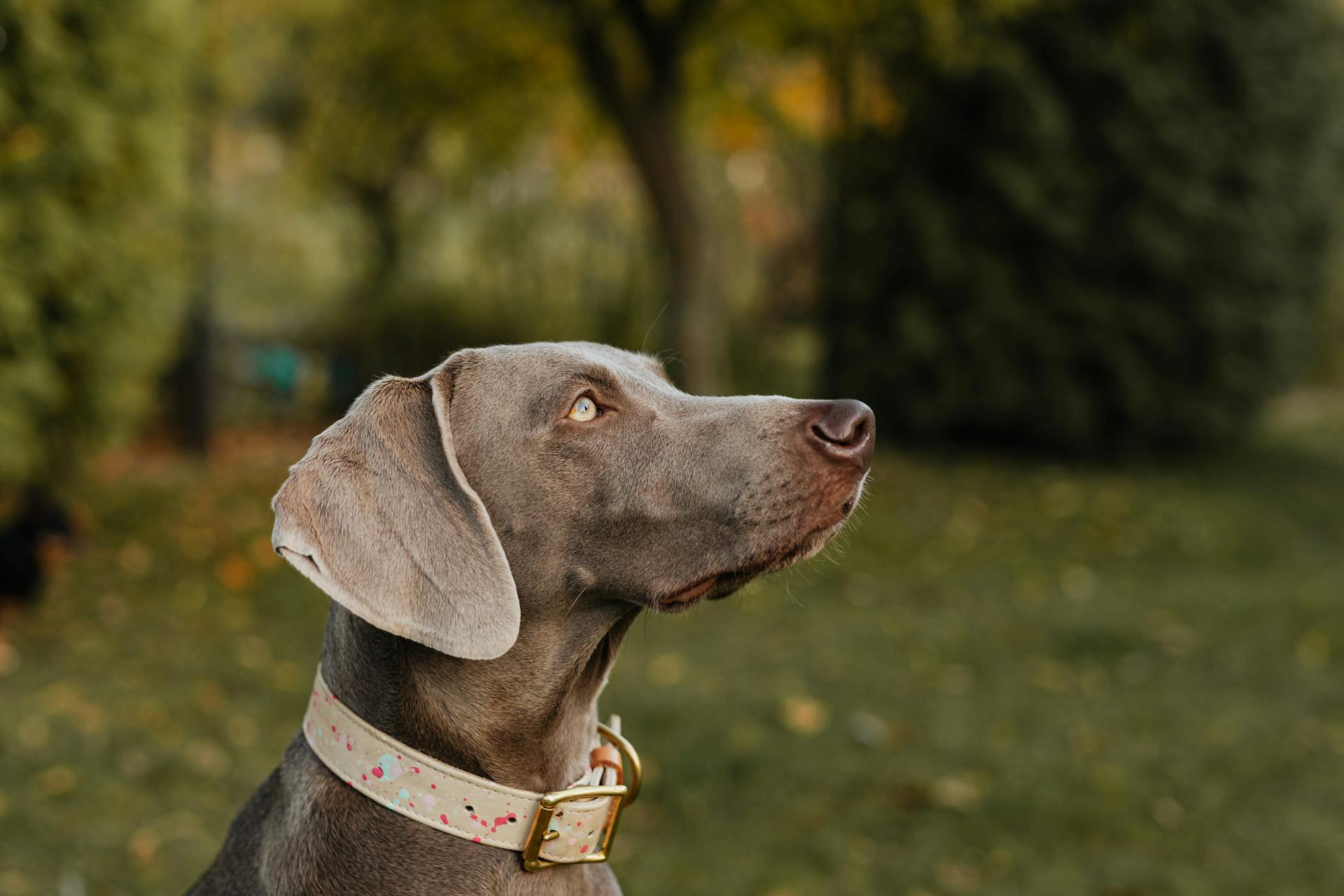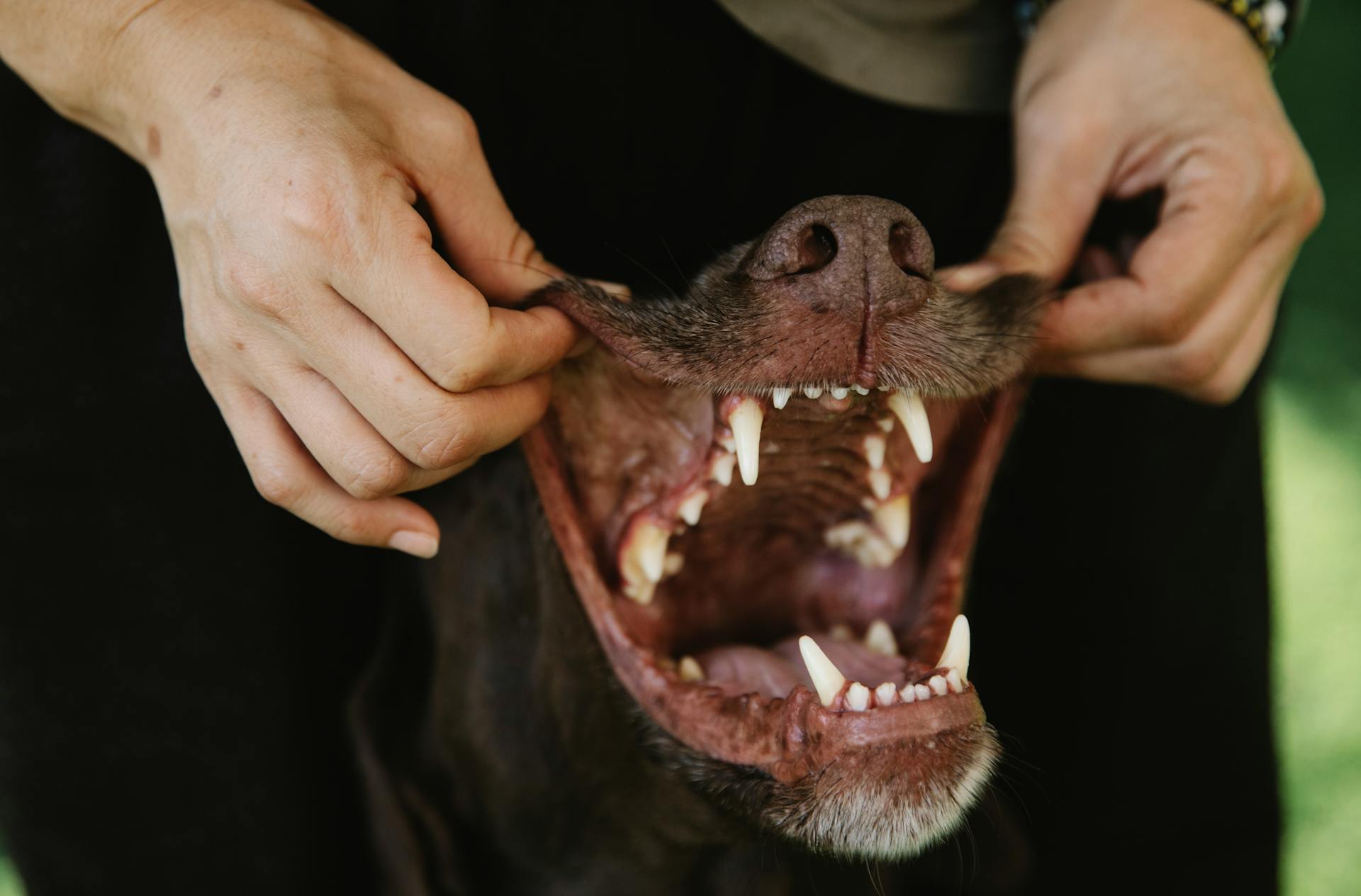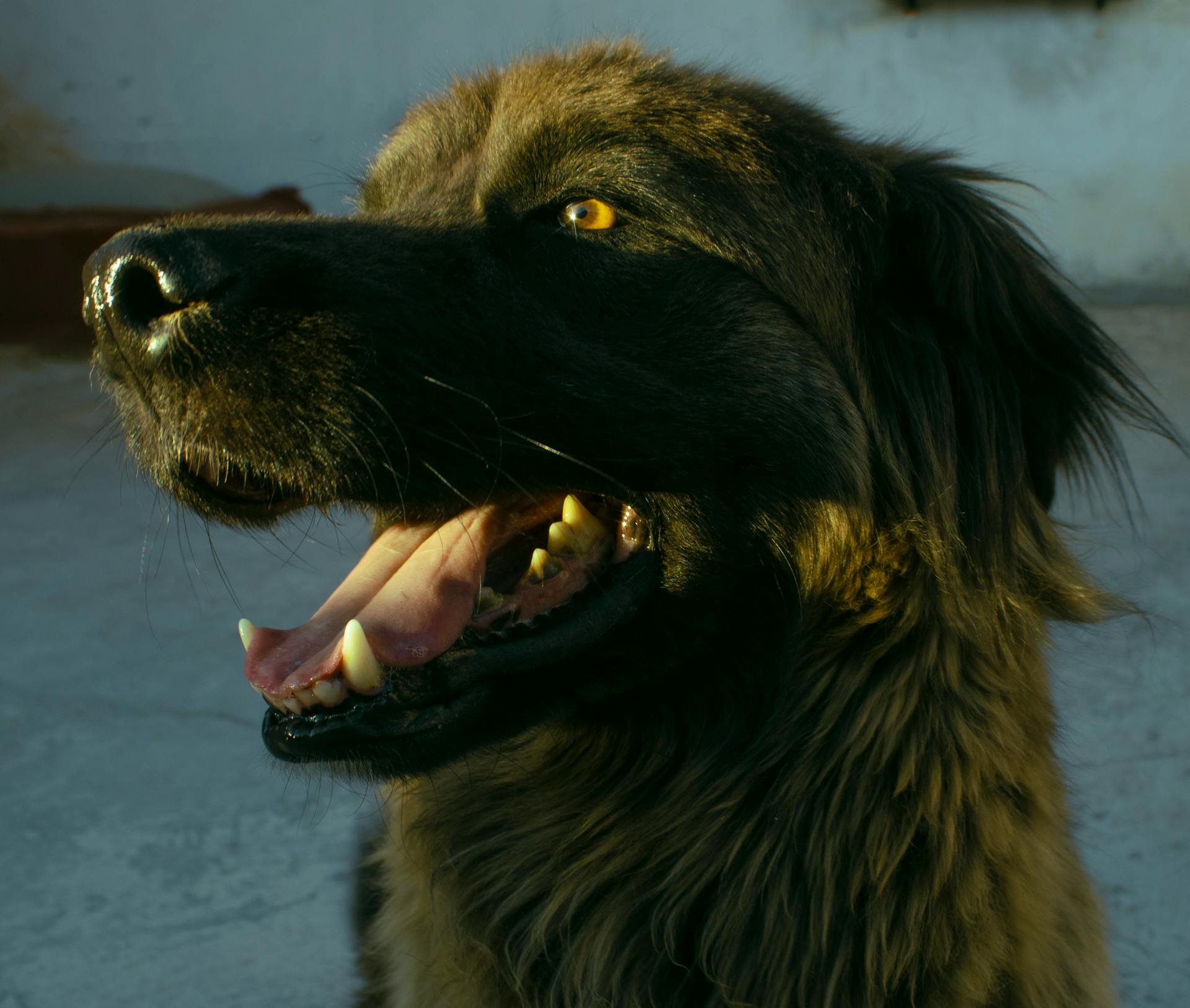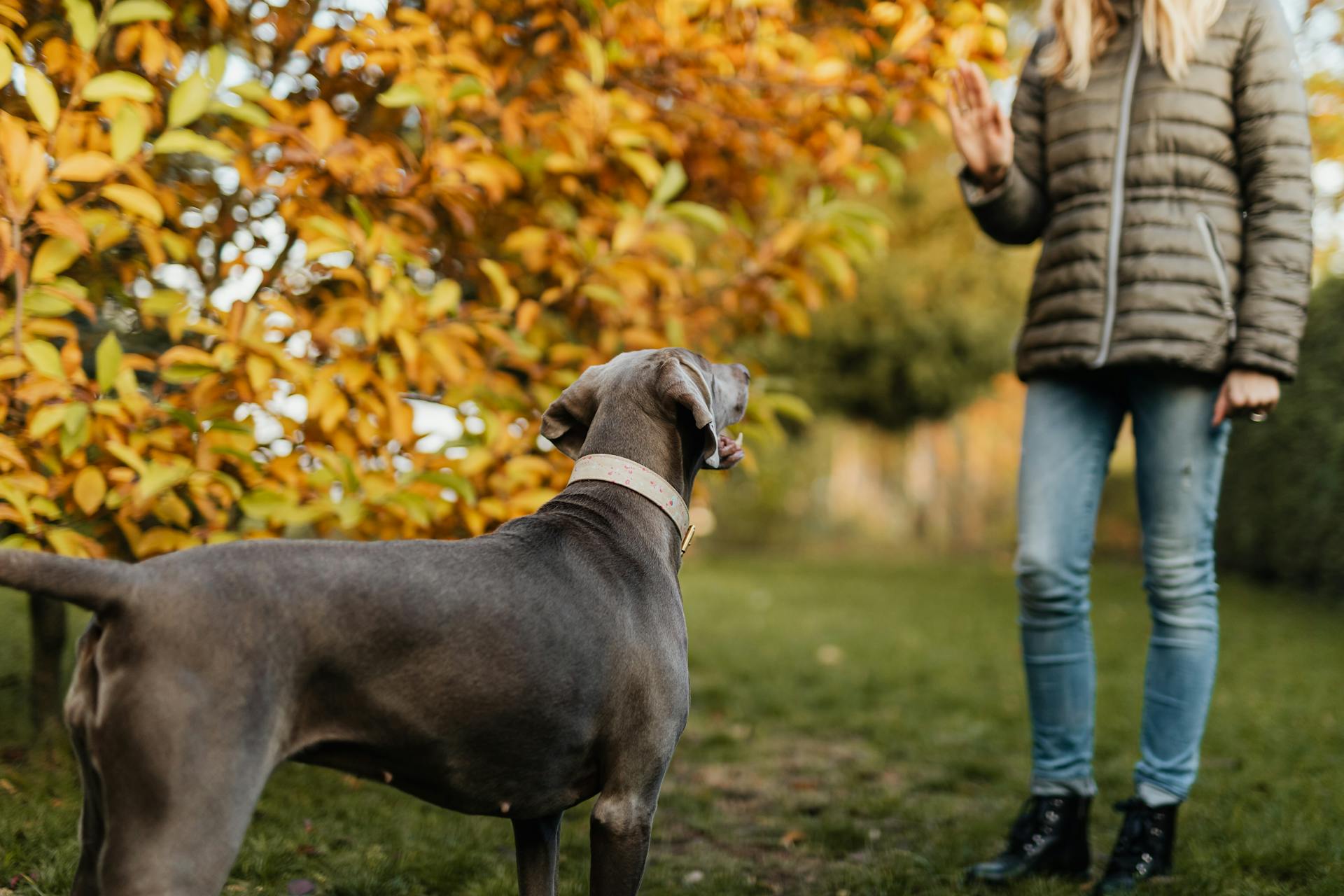
The Boerboel is a majestic breed that's steeped in history and tradition. Originating from South Africa, this powerful dog was bred to guard and protect livestock from predators.
Boerboels are naturally protective of their families and territories, making them excellent watchdogs. They can be wary of strangers, but with proper socialization, they can learn to be friendly and welcoming.
A Boerboel's size can be intimidating, with males weighing up to 200 pounds and standing as tall as 27 inches at the shoulder. But don't let their massive stature fool you - they're also known for being gentle and loving with their families.
Physical Characteristics
The Boerboel's physical characteristics are a testament to its impressive size and strength. They can weigh between 150-200 pounds and stand as tall as 27 inches.
The Boerboel's head is a distinctive feature, with a blocky, broad, deep, square, and muscular shape. It's proportionate to the rest of the body and has moderate wrinkles when attentive.
Their muzzle blends smoothly with the skull, and the nasal bone measures approximately one-third the total length of the head. The muzzle is broad and deep, tapering slightly to the front.
The Boerboel's coat is short, smooth, dense, and shiny, coming in a range of colors including red, brown, reddish-brown, fawn, and cream, often with black coloring in the shape of a mask on their face.
Their ears are V-shaped and rounded at the tip, usually folding over and laying flat. Eyes are dark brown and horizontally set, giving the Boerboel a characteristic alert and intelligent expression.
Their neck is powerful and medium in length, gradually increasing in width from the head to the shoulder. The head and neck do not show excessive skin, and the scruff may be loose, but not excessive.
Here's a summary of the Boerboel's physical characteristics:
Body
The Boerboel's body is a testament to its impressive physicality. It's slightly longer than tall, with the body measuring 10 to 15 percent longer than the height at the withers.
The ribcage is well sprung, with maximum volume, and the back is broad, straight, and well-muscled. The torso has adequate width and depth, with a level, straight-appearing topline and a defined muscular ridge above the withers.
The loin is wide, with adequate depth, short (ideally one-third of total torso length), and flattened at the top. The abdomen should show a slight to moderate tuck up.
Here's a breakdown of the Boerboel's body proportions:
The Neck
The neck of this breed is quite impressive, with a gradual increase in width from the head to the shoulder. It's a medium length, powerful, and has an arched crest.
The skin on the neck is relatively tight, with a scruff that may be loose but not excessive. The dewlap, if present, should be noticeable but not too prominent.
The neck's medium length is a defining characteristic of this breed, making it a standout feature.
Forequarters
The forequarters are a crucial part of a dog's physical characteristics, and they play a big role in their overall mobility.

The forequarters are well angulated, which means they're designed to move smoothly and efficiently. This is essential for a dog to be agile and nimble.
The scapula, or shoulder blades, are well attached and spaced for optimal mobility. This allows for a full range of motion, making it easier for a dog to run, jump, and play.
The upper and lower arms are of about equal length and well laid back. This balanced structure helps a dog to move with ease and precision.
The forechest is wide but not excessive, which provides a stable base for a dog's front legs. This is important for supporting their body weight and facilitating movement.
Explore further: Standard Pomeranian Dog
Hindquarters
The hindquarters of a dog are a vital part of its overall structure, and there are some key characteristics to look for.
The hindquarters should be well angulated, well-muscled and deep and broad, especially in bitches. This means they should have a sturdy and athletic appearance.

The croup, which is the area at the top of the hindquarters, should be broad and of good length, and set slightly sloping. This helps to give the dog its characteristic shape and movement.
The upper thighs should be broad, deep and muscular, with substantial thickness when viewed in profile and from the rear. This is important for the dog's overall power and agility.
The lower thighs should be correctly angulated, of equal length to the upper thigh, and display well-developed musculature down to the hock. This helps to ensure the dog's legs are strong and stable.
The hocks, which are the joints at the back of the dog's legs, should be strong and sturdy, of medium length, and in proportion to the rest of the leg. They should also be parallel and in line with the rest of the leg when viewed from the rear.
The rear pasterns, which are the bones at the back of the dog's legs, should be relatively short, strong and of adequate girth. They should also be parallel with each other when viewed from the rear.
Curious to learn more? Check out: Bernese Mountain Dog Standard
Tail

The tail of a Boerboel is a unique feature that's worth noting. It's a natural extension of the spine, set fairly high, and well covered with hair.
Long tails taper to the end and are sabre shaped, often reaching down to the hocks or a little below. They're quite variable from dog to dog, but most are long and tapering.
The natural tail of a Boerboel hangs slightly curved when the dog is standing, and carried with a slight upward curve when the dog is excited or moving. It shouldn't curl over the back.
Docked tails are traditionally docked at the third or fourth caudal vertebrae.
Worth a look: When Does a Standard Poodle Stop Growing
Coat and Grooming
The Boerboel's coat is a key part of its overall appearance. It's sleek, short, smooth, and dense.
Regular grooming is essential to keep the coat in top condition. This means regular brushing to prevent matting and tangling.
The skin of a Boerboel is surprisingly thick, which can be beneficial in hot climates. It's also loose, but not excessively so, which can help prevent irritation.
Dark pigmentation on the skin is a common feature of the Boerboel breed.
Growth and Development
Boerboels are massive dogs that experience colossal growth spurts as puppies. They can weigh anywhere from 5 to 20 pounds at one month old.
Boerboel growth is a gradual process, but it's essential to keep track of their weight and height to ensure they're developing healthily. Refer to the Boerboel growth chart to see the healthy weight range for their age.
Boerboels take a long time to mature, with most puppies growing for at least a year and a half to reach their full size. In fact, many Boerboels require up to two years to finish filling out.
Here's a rough estimate of how much bigger your Boerboel puppy will get, based on their age:
- Less than a year old: Still growing and may have a lot of weight to gain
- Closer to two years old: Likely close to full-size
You can also predict your Boerboel's size at maturity by looking at their paw size. If their paws look disproportionately large next to their legs and body, then it's likely they are still filling out and need more time to grow.
Consider reading: Schnauzer Sizes and Weights
Boerboels' genes play a critical role in determining how large they will grow to be, so if you buy a Boerboel from a breeder, ask about their expected size in adulthood based on their parents and their past litters.
On average, a six-month-old Boerboel weighs around 80 to 100 pounds. However, your pup may weigh slightly more or less than this depending on their gender and individual growth rate.
A Boerboel's height should stand between 22 and 27 inches tall, depending on their gender. The healthy Boerboel weight range for both genders is 150 to 200 pounds.
Here's a quick reference guide to help you keep track of your Boerboel's growth:
Health and Lifespan
A Boerboel's lifespan can range from 10 to 12 years, which is impressive for a breed of its size.
While they may live longer than other large dog breeds, Boerboels are still prone to certain genetic diseases.
Wobbler syndrome is a significant concern for Boerboels, primarily affecting large and giant breeds like them.
This condition can cause a wobbly gait, neck pain, and a reluctance to walk due to spinal cord compression.
Medical intervention can improve the symptoms for 50% of affected dogs, and another 30% will stabilize, allowing many to live long and happy lives.
Genetic diseases like wobbler syndrome can be a challenge for Boerboel owners, but with proper care and attention, many dogs can thrive.
Breed Information
The Boerboel is a large and powerful dog breed, originally bred in South Africa to guard and protect livestock.
They typically weigh between 110-175 pounds and stand 24-27 inches tall at the shoulder.
Boerboels are known for their distinctive physical appearance, with a broad chest and well-sprung ribs.
Their short, smooth coat requires minimal grooming, making them a low-maintenance choice for some owners.
Boerboels are naturally protective of their family and territory, but they can also be loyal and loving companions.
They are generally quiet dogs, but may bark to alert their owners to potential threats.
Boerboels are intelligent and trainable, but can be stubborn at times, requiring patient and consistent training.
They thrive on physical and mental stimulation, making them a great choice for active families or individuals.
Boerboels are generally healthy dogs, but can be prone to certain health issues such as hip dysplasia and eye problems.
Their lifespan is typically 10-12 years, with some living up to 14 years or more with proper care and attention.
Care and Needs
Boerboels aren't low maintenance, they need a lot of time spent in training and exercising to build a deep bond with your pup.
Daily exercise is a must, whether that be long walks on a leash or plenty of play in a fenced-in backyard. Boerboels aren't super active dogs, but they do need it.
A big yard is ideal, but not essential - as long as you meet their exercise needs, they tend to be a little lethargic at home. Big dogs can make great apartment dogs.
Boerboels can get along well with other pets in the home, especially if they are raised together, and come down to socialization and training.
Grooming is easy, a weekly go-over with a soft-bristled brush or grooming mitt will keep their dense, short coat looking sleek and healthy.
Boerboels are agile dogs who love to swim and go on long hikes, and they'll happily snooze the day away if they get enough exercise.
They need quite a bit of food to keep them full, and that can quickly add up - so make sure your wallet can handle the bills as well as dedicating time to train and socialize these pups.
Take a look at this: Standard Poodle Grooming Styles
Frequently Asked Questions
What two breeds make a Boerboel?
The Boerboel is a cross between mastiffs and bulldogs, bred for guarding and hunting. This unique heritage makes the Boerboel a formidable and versatile breed.
Does AKC recognize Boerboel?
Yes, the AKC recognizes the Boerboel breed. It was officially recognized in 2015.
Featured Images: pexels.com
